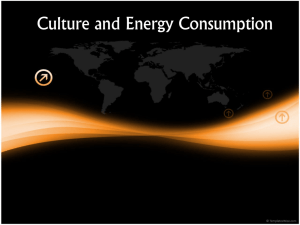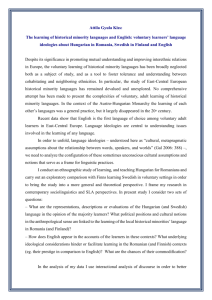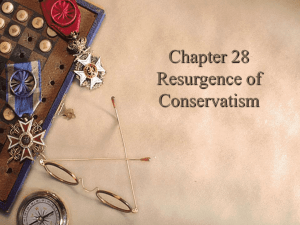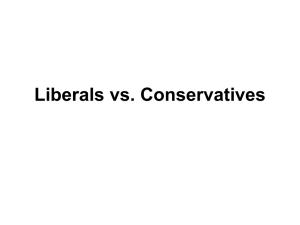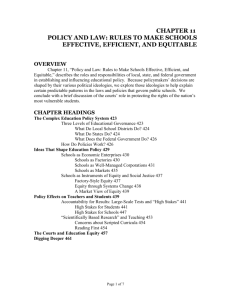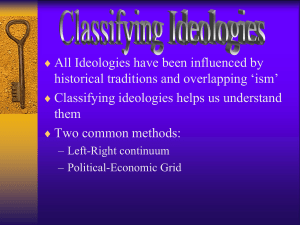File
advertisement
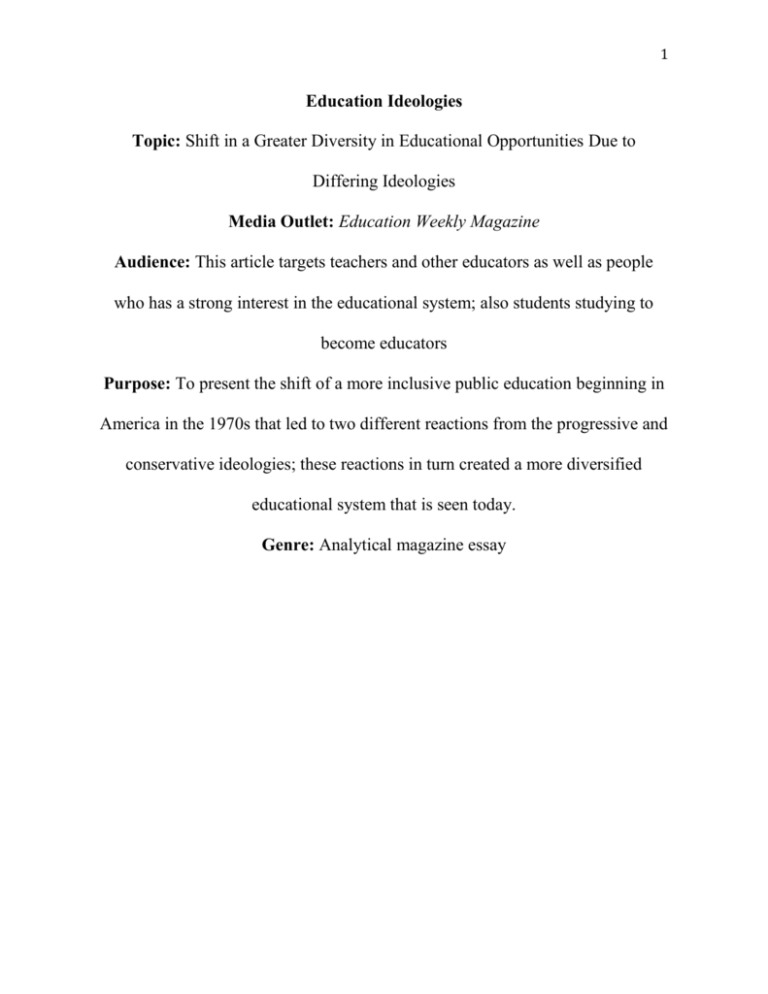
1 Education Ideologies Topic: Shift in a Greater Diversity in Educational Opportunities Due to Differing Ideologies Media Outlet: Education Weekly Magazine Audience: This article targets teachers and other educators as well as people who has a strong interest in the educational system; also students studying to become educators Purpose: To present the shift of a more inclusive public education beginning in America in the 1970s that led to two different reactions from the progressive and conservative ideologies; these reactions in turn created a more diversified educational system that is seen today. Genre: Analytical magazine essay 2 Abby Cosgrove Professor Pisani-Babich English 137H 9 November 2014 Education Ideologies The one thing that all of humanity has in common is the desire to learn. Not necessarily learning in the academic sense but learning in life as a whole. There has been much discrepancy on which is the best way to learn. This argument is ongoing and it is what drives the evolution of the educational system throughout history. American history, in particular, has experienced several paradigm shifts in the public view of education. Throughout the past few decades, American education has changed once more. Public school beginning around the 1970s embraced a more intellectually, ethically, and economically diverse student body. The shift towards a more inclusive public education resulted in different reactions from both the conservative and progressive ideologies; these reactions in turn ultimately led to more diversified educational opportunities. Beginning in the 1970s, different reforms came into effect surrounding education. The Equal Education Opportunities Act of 1974 provided that no state could deny educational opportunity on the basis of race, sex, or national origin (Federal-State). This along with the Rehabilitation Act of 1973 and the Education for All Handicapped Children Act of 1975 allowed for public schools to become more integrated in every aspect. With the aftermath of these new reforms occurring in the 1970s, many people believed that public schools had become chaotic and less effective since the new changes were hard to initially integrate 3 efficiently. This in turn started the migration of students from public school systems to more privatized institutions. Economic problems during the 1980s also led towards feelings of disenchantment with public education. More people began to connect the economic downturn to the poor system of education (School Reform). During this time, several educational reforms were proposed –as reactions to the mandated changes in the 1970s– under the Reagan administration. Throughout this period many suggested “school choice” as a solution to improving education. School choice means that students and their parents can choose either a public or private school and either option will be paid for using public funds. While only a few states put this reform into effect, it gave others the idea that private school may be the better option for their children. Since conservatives wanted to minimize the influence of government, their goal is to privatize public schools. Conservatives believe that “school is a consumer good serving multiple, private interests” (Keedy). Through charter schools and other alternative forms of schooling, parents can choose schools consonant with their own ideological views. Conservatives condemn public schools and associate them with America’s moral decay and government inefficiency. Since secularization, democracy, and other societal issues have become prominent and widespread in public schools, there has been much uproar from the more conservative communities. The perception that American society has moved away from the core moral values also associates this shift with the public schools. Through charter, parochial, private, and home schooling, parents are able to insulate their kids from the worldly aspect of public education. 4 The conservative politicians have an agenda to undermine public education because public educators make up one of the largest liberal collective groups in the United States. Conservative politicians would like to dismantle these public school unions. The conservative views education as something that can be treated as a private good and therefore is a service provided to individuals that can be consumed in individual units who have the same beliefs. Therefore their reactions towards the all-encompassing shift in public education led them to support breaking away from that type of government-sponsored schooling towards other alternative forms of education. Progressives attempted to spread America’s concept of democracy throughout the urban industrialized world. They thought of no better way to do that than to teach young children the value of democracy, citizenship and equality. They believed that the public school was characterized by the “traditions of multiculturalism, the importance of diversity, and promoting equal opportunity and funding for all Americans” (Bracey). Therefore the majority supported the newer shift towards more inclusive educational opportunities. The progressives or commonwealth views education as a public good, a service that cannot be broken down into individual units (Baughman). They believe that the entire society has a stake in public schools and therefore the school system should reflect society as a whole. Public schools were meant to be secular and tried to be as inclusive as possible. Newer political reforms reflecting both conservative and progressive ideologies have been recently proposed within the past few years (Chira). The conservative wing of education sees declining academic and moral standards as the dangers to American schooling, and the cures to these dangers involve rigorous academic training and moral guidance. By contrast, several designs have been made towards a more progressive education. In these designs, 5 plans have been proposed to help the at-risk youths and create curriculums that better serve the wide range of students in public schools. Along with these failed attempts at new reforms due towards a lack of agreement, the two ideologies are disparate on other educational programs such as early childhood education. Progressives support the funding of early childhood programs such as Head Start, that are aimed at closing the achievement gap between students of higher family incomes and lower family incomes. Conservatives who support the decrease in government funding towards education, believe that those types of early educational programs should be privatized and therefore the varying abilities will help fuel the consumer minded society. Clearly their ideologies clash at all levels of educational policies. Education over the last few decades has indeed shifted. The conservatives and progressives view this shift as beneficial but for different reasons. The progressives would say there is a greater equal opportunity for all in modern public schooling. While the conservatives believe that education had changed for the better because they are now allowed a choice in their schooling preferences. The rise of other alternative schools to public schooling such as parochial, charter, cyber, or home schooling resulted from the reactions to the public school system in American ideologies. Both ideologies are happy that education has changed. Both sides however do not agree on which is the best form of education. 6 Works Cited Baughman, Judith S. "Secularization of Public Education." American Decades 5 (2001): n. pag. Gale Virtual Reference Library. Web. 3 Nov. 2014. <http://go.galegroup.com.ezaccess.libraries.psu.edu>. Bracey, Gerald W. "Education Politics: The Right's Data-Proof Ideologues." Education Week [Bethesda] 25 Jan. 1995, Archives: n. pag. Education Week. Web. 4 Nov. 2014. <http://www.edweek.org/ew/articles/1995/01/25/18bracey.h14.html?qs=educational+i deologies>. Chira, Susan. "In Plans to Improve Schools, a Grab Bag of Ideas and Ideologies." New York Times [New York] 15 July 1992, Archives: n. pag. The New York Times. Web. 3 Nov. 2014. <http://www.nytimes.com/1992/07/15/education/in-plans-to-improve-schools-agrab-bag-of-ideas-and-ideologies.html>. "Federal-State Education Policy Chronology 1970-1979." States' Impact on Federal Education Policy. US Department of Education, n.d. Web. 2 Nov. 2014. <http://www.archives.nysed.gov/edpolicy/research/res_chronology1970.shtml>. Keedy, John L. "Ideology, Shifts of in Educational Leadership Preparation." Encyclopedia of Educational Leadership and Administration 1 (2006): 491-93. Gale Virtual Reference Library. Web. 4 Nov. 2014. <http://go.galegroup.com.ezaccess.libraries.psu.edu>. "School Reform - A Nation at Risk, Reform in Action, Greater Goals Better Teachers and More Accountability." StateUniversity.com. Education Encyclopedia, n.d. Web. 4 Nov. 2014. <http://education.stateuniversity.com/pages/2400/School-Reform.html>.

